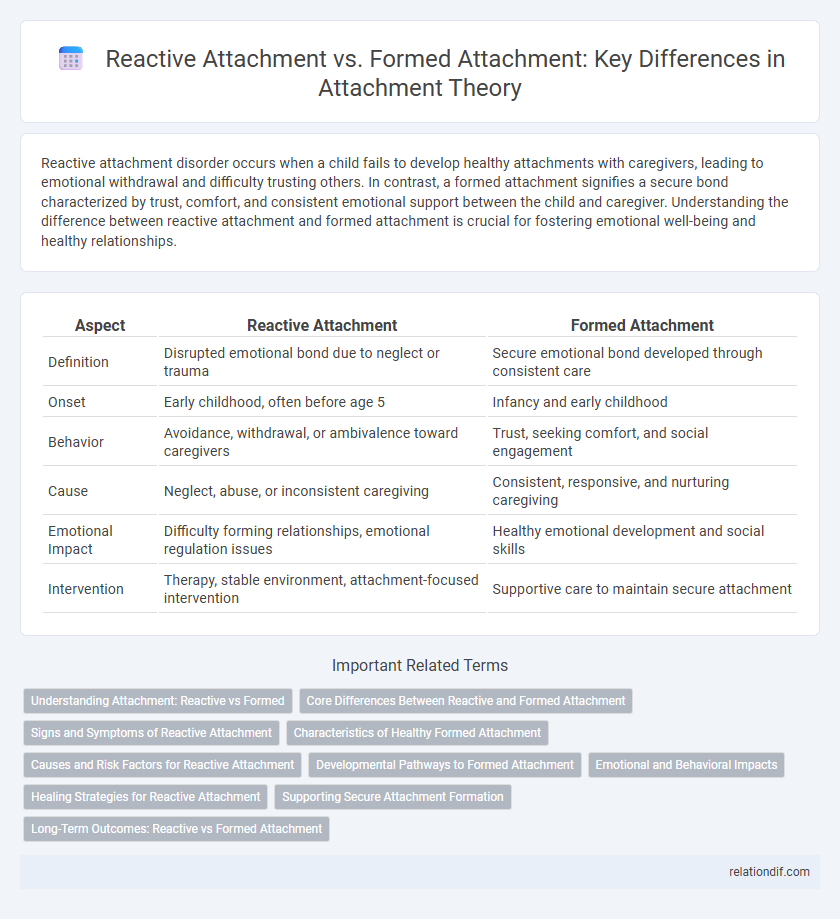Reactive attachment disorder occurs when a child fails to develop healthy attachments with caregivers, leading to emotional withdrawal and difficulty trusting others. In contrast, a formed attachment signifies a secure bond characterized by trust, comfort, and consistent emotional support between the child and caregiver. Understanding the difference between reactive attachment and formed attachment is crucial for fostering emotional well-being and healthy relationships.
Table of Comparison
| Aspect | Reactive Attachment | Formed Attachment |
|---|---|---|
| Definition | Disrupted emotional bond due to neglect or trauma | Secure emotional bond developed through consistent care |
| Onset | Early childhood, often before age 5 | Infancy and early childhood |
| Behavior | Avoidance, withdrawal, or ambivalence toward caregivers | Trust, seeking comfort, and social engagement |
| Cause | Neglect, abuse, or inconsistent caregiving | Consistent, responsive, and nurturing caregiving |
| Emotional Impact | Difficulty forming relationships, emotional regulation issues | Healthy emotional development and social skills |
| Intervention | Therapy, stable environment, attachment-focused intervention | Supportive care to maintain secure attachment |
Understanding Attachment: Reactive vs Formed
Reactive attachment disorder occurs when a child fails to develop a healthy emotional bond with caregivers in early childhood, often resulting in difficulty trusting others and managing emotions. Formed attachment represents a secure and stable emotional connection established through consistent, responsive caregiving, fostering trust and social development. Understanding the distinctions between reactive and formed attachment is crucial for addressing emotional and behavioral challenges in affected children.
Core Differences Between Reactive and Formed Attachment
Reactive attachment disorder (RAD) arises from severe neglect or abuse, leading to difficulty in forming healthy emotional bonds, characterized by withdrawal and inability to seek comfort. Formed attachment reflects secure emotional connections developed through consistent caregiving, fostering trust and empathy in relationships. Core differences lie in the presence of emotional regulation, trust development, and the capacity to engage in meaningful social interactions.
Signs and Symptoms of Reactive Attachment
Reactive attachment disorder (RAD) is characterized by symptoms such as difficulty forming emotional bonds, lack of responsiveness to caregivers, and social withdrawal. Children with RAD may exhibit limited eye contact, failure to seek comfort when distressed, and inconsistent or inappropriate social interactions. These signs differentiate reactive attachment from formed attachment, where secure emotional connections and trust are typically established.
Characteristics of Healthy Formed Attachment
Healthy formed attachment is characterized by consistent emotional responsiveness, secure base behavior, and effective stress regulation in relationships. It fosters trust, empathy, and open communication, enabling individuals to navigate social interactions with confidence and resilience. This type of attachment supports emotional development by promoting a strong sense of safety and connection between caregivers and children.
Causes and Risk Factors for Reactive Attachment
Reactive attachment disorder (RAD) primarily develops from severe neglect, abuse, or inconsistent caregiving during early childhood, disrupting the normal formation of secure attachments. Risk factors include prolonged institutionalization, frequent changes in primary caregivers, and exposure to traumatic events that hinder emotional bonding. These conditions prevent children from developing trust and healthy relational patterns, distinguishing reactive attachment from typically formed attachments.
Developmental Pathways to Formed Attachment
Developmental pathways to formed attachment involve consistent caregiver responsiveness that fosters secure emotional bonds, differentiating it from reactive attachment which arises from neglect or inconsistent care. Neural mechanisms, including the regulation of oxytocin and cortisol, support the transition from initial reactive states to stable, formed attachments. Early interventions targeting caregiver sensitivity can promote healthy attachment development and mitigate risks associated with reactive attachment disorder.
Emotional and Behavioral Impacts
Reactive attachment disorder (RAD) often results in severe emotional difficulties, including impaired ability to trust, difficulty forming emotional bonds, and heightened anxiety or withdrawal behaviors. In contrast, formed attachment fosters secure emotional connections, promoting empathy, resilience, and healthy social interactions. Behavioral impacts of reactive attachment include aggression, defiance, and difficulties in peer relationships, whereas formed attachment supports effective emotional regulation and positive social engagement.
Healing Strategies for Reactive Attachment
Healing strategies for reactive attachment focus on creating a safe, consistent environment to rebuild trust and emotional connections. Therapeutic interventions such as trauma-focused cognitive behavioral therapy, attachment-based therapy, and family therapy promote secure attachment by addressing emotional dysregulation and fostering supportive relationships. Consistent caregiver responsiveness, structured routines, and positive reinforcement are essential in helping children with reactive attachment disorder develop healthy relational patterns.
Supporting Secure Attachment Formation
Supporting secure attachment formation involves recognizing the differences between reactive attachment disorder (RAD), characterized by difficulties in forming bonds, and formed attachment, where a child develops a consistent, trusting relationship with caregivers. Interventions focus on creating stable, responsive caregiving environments, promoting emotional availability and sensitivity that are crucial for healthy brain development and social-emotional growth. Early therapeutic support and parent-child interaction therapies play vital roles in helping children transition from reactive attachment patterns to secure attachments.
Long-Term Outcomes: Reactive vs Formed Attachment
Reactive attachment, often stemming from early neglect or inconsistent caregiving, is linked to long-term challenges such as difficulty in forming healthy relationships, emotional dysregulation, and increased risk of mental health disorders. In contrast, formed attachment, characterized by consistent and responsive caregiving, generally results in secure emotional bonds, better social skills, and improved psychological resilience throughout life. Studies highlight that interventions promoting secure attachment can significantly mitigate adverse outcomes associated with reactive attachment disorder.
reactive attachment vs formed attachment Infographic

 relationdif.com
relationdif.com